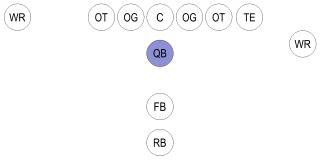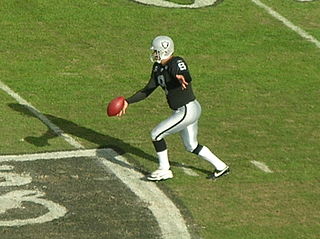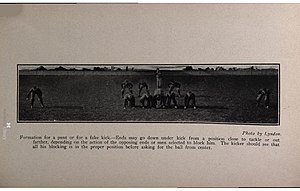
The quarterback, colloquially known as the "signal caller", is a position in gridiron football. Quarterbacks are members of the offensive platoon and mostly line up directly behind the offensive line. In modern American football, the quarterback is usually considered the leader of the offense, and is often responsible for calling the play in the huddle. The quarterback also touches the ball on almost every offensive play, and is almost always the offensive player that throws forward passes. When the QB is tackled behind the line of scrimmage, it is called a sack.

A play-action pass is an American football play. The play action starts with what appears to be a running play, but turns out to be a pass play; in this way, it can be considered the opposite of a draw play. Play-action passes are often used against defenses that are focused on stopping the run. By initially simulating a running play, the offense attempts to deceive the defense into acting on the fake run placing them out of position in their pass coverage, and giving receivers more time and room to be free to receive passes behind the linebackers.

A down is a period in which a play transpires in gridiron football. The down is a distinguishing characteristic of the game compared to other codes of football, but is synonymous with a "tackle" in rugby league. The team in possession of the football has a limited number of downs to advance ten yards or more towards their opponent's goal line. If they fail to advance that far, possession of the ball is turned over to the other team. In most situations, if a team reaches their final down they will punt to their opponent, which forces their opponent to begin their drive from further down the field; if they are in range, they might instead attempt to score a field goal.
Strategy forms a major part of American football. Both teams plan many aspects of their plays (offense) and response to plays (defense), such as what formations they take, who they put on the field, and the roles and instructions each player are given. Throughout a game, each team adapts to the other's apparent strengths and weaknesses, trying various approaches to outmaneuver or overpower their opponent in order to win the game.
A free kick in rugby union is usually awarded to a team for a technical offence committed by the opposing side. Free kicks are awarded for technical offences such as playing too many players in a line-out or time wasting at a scrum. A free kick is also awarded for making a mark.

A punter (P) in gridiron football is a special teams player who receives the snapped ball directly from the line of scrimmage and then punts (kicks) the football to the opposing team so as to limit any field position advantage. This generally happens on a fourth down in American football and a third down in Canadian football. Punters may also occasionally take part in fake punts in those same situations, when they throw or run the football instead of punting.
A formation in football refers to the position players line up in before the start of a down. There are both offensive and defensive formations and there are many formations in both categories. Sometimes, formations are referred to as packages.
In American football, the fumblerooski is a trick play in which the football is intentionally and stealthily placed on the ground (fumbled) by an offensive player, usually the quarterback. The offensive team then attempts to distract and confuse the defense by pretending that a ball carrier is running in one direction while another offensive player retrieves the ball from the turf and runs in a different direction, hoping to gain significant yardage before the defense realizes which player is actually carrying the football.

A flea flicker is an unorthodox play, often called a "trick play", in American football which is designed to fool the defensive team into thinking that a play is a run instead of a pass. It can be considered an extreme variant of the play action pass and an extension of the halfback option play.

In gridiron football, the holder is the player who receives the snap from the long snapper during field goal or extra point attempts made by the placekicker. The holder is set on one knee seven yards behind the line-of-scrimmage. Before the play begins, he places the hand which is closest to the placekicker on the ground in a location designated by the kicker's foot, with his forward hand ready to receive the snap. After receiving the snap, the holder will place the football on the turf, or block, ideally with the laces facing the uprights and the ball accurately placed where the backhand was initially, then balancing the ball with one or two fingers until the ball is kicked.
A trick play, also known as a gadget play, gimmick play or trickeration, is a play in gridiron football that uses deception and unorthodox tactics to fool the opposing team. A trick play is often risky, offering the potential for a large gain or a touchdown if it is successful, but with the chance of a significant loss of yards or a turnover if not. Trick plays are rarely used not only because of the riskiness, but also to maintain the element of surprise for when they are used.

In American football, the specific role that a player takes on the field is referred to as their "position". Under the modern rules of American football, both teams are allowed 11 players on the field at one time and have "unlimited free substitutions", meaning that they may change any number of players during any "dead ball" situation. This has resulted in the development of three task-specific "platoons" of players within any single team: the offense, the defense, and the so-called 'special teams'. Within these three separate "platoons", various positions exist depending on the jobs that the players are doing.
In American football, a play is a close-to-the-ground plan of action or strategy used to move the ball down the field. A play begins at either the snap from the center or at kickoff. Most commonly, plays occur at the snap during a down. These plays range from basic to very intricate. Football players keep a record of these plays in a playbook.
The following terms are used in American football, both conventional and indoor. Some of these terms are also in use in Canadian football; for a list of terms unique to that code, see Glossary of Canadian football.
In gridiron football, a turnover on downs occurs when a team's offense has used all their downs but has not progressed downfield enough to earn another set of downs. The resulting turnover gives possession of the ball to the team currently on defense.
A fake field goal is a trick play in American football. Simply, it involves a running or passing play done out of a kick formation. Usually the holder will throw or run. Less frequently, the placekicker, who virtually never handles the ball in an American football game, will serve as the passer or rusher on a fake field goal.

In gridiron football, a punt is a kick performed by dropping the ball from the hands and then kicking the ball before it hits the ground. The most common use of this tactic is to punt the ball downfield to the opposing team, usually on the final down, with the hope of giving the receiving team a field position that is more advantageous to the kicking team when possession changes. The result of a typical punt, barring any penalties or extraordinary circumstances, is a first down for the receiving team. A punt is not to be confused with a drop kick, a kick after the ball hits the ground, now rare in both American and Canadian football.
In American football, the upback is a blocking back who lines up approximately 1–3 yards behind the line of scrimmage in punting situations.

The Colts Catastrophe was an unsuccessful National Football League (NFL) trick play attempted by the Indianapolis Colts against the New England Patriots on October 18, 2015. It occurred near the end of the third quarter in the teams' Week 6 game of the 2015 NFL season.

The run-pass option (RPO) is a type of designed option play in gridiron football in which the offensive team has the ability to either rush or pass the ball depending on the alignment and actions of defensive team. Like the standard read-option, the quarterback is responsible for viewing the actions of a particular defender and makes a decision to hand the ball off to their running back depending on how that defender chooses to act after the snap of the ball. However, unlike the read-option, the quarterback is responsible for making a decision regarding whether or not to throw a play-action pass to a receiver running a designed route, rather than simply the decision to keep the ball and run with it.










